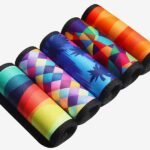When it comes to protecting your car’s seats, seat covers are essential. Two of the most popular options for high-quality seat covers are neoprene and neosupreme. But with so many choices available, how do you know which material is right for you? In this comprehensive guide, we will compare neoprene vs neosupreme seat covers, diving deep into their properties, durability, comfort, and other important factors to help you make an informed decision. By the end of this article, you’ll have a clear understanding of which material suits your needs best and why these materials are top choices for customers seeking reliable, customizable seat cover solutions.
Neoprene and neosupreme seat covers offer excellent protection and comfort, but each has its own unique qualities. Neoprene is renowned for its durability and weather resistance, while neosupreme is a more affordable alternative with similar benefits.
Before diving into the specifics of each material, let’s first understand the basics. What are neoprene and neosupreme seat covers, and how do they differ?
What Are Neoprene and Neosupreme Seat Covers?
Neoprene seat covers are made from synthetic rubber material that is both flexible and durable. It is commonly used in wetsuits due to its excellent ability to provide insulation and water resistance. Neoprene seat covers are designed to fit snugly over car seats, offering protection from water, dirt, stains, and UV damage. This material is particularly known for its thick, cushioned feel and superior protection.
Neosupreme, on the other hand, is a fabric blend that mimics the look and feel of neoprene but at a more affordable price point. While it doesn’t have the same level of flexibility or insulation properties, it still offers good protection and comfort. Neosupreme seat covers are usually made from a polyester blend with a PVC backing, which provides a soft, comfortable texture and a decent level of water resistance.
Neoprene seat covers offer superior durability and insulation, while neosupreme is an affordable alternative with a similar aesthetic, making it a good choice for those on a budget.
Now that you understand what neoprene and neosupreme are, let’s explore which material is best for seat covers. Both materials have distinct advantages, so choosing the right one will depend on your specific needs.
What Material is Best for Seat Covers?
When selecting the best material for seat covers, it’s essential to consider factors like comfort, durability, ease of cleaning, and weather resistance.
-
Neoprene: If you live in a region with varying weather conditions or frequently use your vehicle for outdoor activities (such as camping or beach trips), neoprene may be the best choice. Its ability to repel water, its UV resistance, and its high durability make it ideal for those looking for a long-lasting solution. Additionally, neoprene’s insulating properties help keep seats warm in cold weather and cool in hot conditions.
-
Neosupreme: If you’re looking for a more budget-friendly option that still offers decent durability and comfort, neosupreme could be the way to go. While it doesn’t offer the same level of weather resistance as neoprene, it’s a good choice for drivers in more temperate climates or those who want a stylish option without breaking the bank. Neosupreme provides good protection against spills and dirt, though it may not be as long-lasting as neoprene.
The best material for seat covers depends on your climate and budget. Neoprene excels in weather resistance and durability, while neosupreme offers a more cost-effective alternative with reasonable durability.
Both materials have their strengths, but each also comes with a few drawbacks. Let’s take a closer look at the downside of neoprene seat covers.
What is the Downside to Neoprene Seat Covers?
While neoprene offers numerous benefits, it’s not without its downsides:
-
Cost: Neoprene is typically more expensive than neosupreme due to its higher quality and specialized manufacturing process. For those on a tight budget, this might be a dealbreaker.
-
Heat Retention: Neoprene’s insulating properties can be a double-edged sword. While it keeps you warm in cold temperatures, it can also become uncomfortable in very hot weather. Neoprene seat covers can trap heat, making the seats feel hot and sticky in the summer.
-
Maintenance: While neoprene is easy to clean, it does require more frequent maintenance to prevent wear and tear, especially in high-use vehicles. Prolonged exposure to direct sunlight can cause neoprene to degrade over time, leading to cracking or fading.
While neoprene offers excellent weather resistance and durability, its higher cost, heat retention in summer, and maintenance needs are some potential downsides.
Now that we’ve covered the drawbacks of neoprene, let’s dive into the main differences between neoprene and neosupreme seat covers.
What is the Difference Between Neoprene and Neosupreme Seat Covers?
The main differences between neoprene and neosupreme seat covers revolve around material composition, durability, and price:
-
Material Composition: Neoprene is made from synthetic rubber, while neosupreme is a polyester blend with a PVC backing. This gives neoprene a more substantial feel, while neosupreme offers a softer, more fabric-like texture.
-
Durability: Neoprene tends to be more durable and long-lasting, especially in extreme conditions. Neosupreme, while still durable, doesn’t hold up as well over time, particularly under intense UV exposure or harsh weather conditions.
-
Price: Neoprene is generally more expensive than neosupreme due to its higher-quality material and manufacturing process. Neosupreme is a cost-effective option for those looking to save money while still getting a protective and comfortable seat cover.
Neoprene and neosupreme differ in material, durability, and price. Neoprene is more durable and offers superior protection, while neosupreme is a more affordable option with similar aesthetic appeal.
With the differences between neoprene and neosupreme in mind, let’s explore which material is more durable overall.
Which Material is More Durable: Neoprene or Neosupreme?
Neoprene is the clear winner when it comes to durability. Thanks to its rubber-like composition, neoprene is resistant to abrasion, UV rays, water, and heat. It performs exceptionally well in harsh environments, making it ideal for outdoor adventures and vehicles exposed to varying weather conditions. Neoprene seat covers can last for many years, provided they’re properly maintained.
Neosupreme, while still durable, doesn’t have the same level of resistance as neoprene. It is more prone to wear and tear over time, especially when exposed to sunlight and moisture. However, for those who are looking for a more affordable option and don’t need the highest level of durability, neosupreme can still provide adequate protection and comfort for several years.
Neoprene is more durable than neosupreme, with superior resistance to UV rays, moisture, and wear and tear. Neosupreme, though slightly less durable, is a good option for those seeking a budget-friendly choice.
Conclusion
In conclusion, choosing between neoprene and neosupreme seat covers comes down to your specific needs. If you require a high level of durability, weather resistance, and comfort, neoprene is the clear choice. However, if you’re on a budget or live in a milder climate, neosupreme offers a good balance of quality and affordability. Both materials provide excellent protection for your car seats, so it ultimately depends on your personal preferences, budget, and usage.
When it comes to customized seat covers that combine durability, comfort, and style, our factory offers premium neoprene seat covers that are designed to meet your exact specifications. Get in touch today to learn more and request a quote for your custom seat covers.











